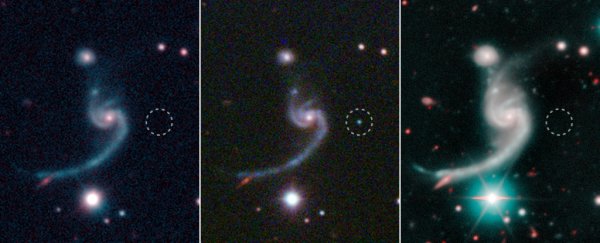When the violent death of a massive star concluded with a whimper instead of a bang, astronomers weren't sure what to make of it. Now it turns out that oddly anaemic death indicates a never-before-seen cosmic phenomenon - the birth of a binary neutron star system, two dead stellar remnants locked in a death spiral.
The event, called iPTF 14gqr (SN 2014ft) was first discovered in October 2014, located on the outskirts of a spiral galaxy some 920 million light years away. It was a core-collapse supernova, but not like any we've seen before.
For a star to go supernova, or spectacularly explode, it has to be at least several times the mass of the Sun; estimates put the minimum at around eight solar masses. At the end of its life, the star runs out of fuel. The core collapses rapidly, which generates a shockwave that explodes the star's outer material.
So, as you can imagine, when the big kaboom happens, it typically blasts several solar masses' worth of material into the surrounding space. But with iPTF 14gqr, that's not what happened. Only material about a fifth of the Sun's mass was ejected in the explosion - and that explosion was pretty weak.
"We saw this massive star's core collapse, but we saw remarkably little mass ejected," said astronomer Mansi Kasliwal of Caltech.
"We call this an ultra-stripped envelope supernova and it has long been predicted that they exist. This is the first time we have convincingly seen core collapse of a massive star that is so devoid of matter."
It wasn't always so naked, though. The star must have had mass to start with in order to be massive enough for its core to collapse. So if it hadn't been ejected in the supernova, it had to have gone somewhere else.
No, not Narnia. The team inferred, based on the strength and mass of the supernova, that the star had a previously unnoticed but very dense binary buddy, such as a white dwarf, black hole, or another neutron star, that stripped off most of its material before the supernova.
This has been modelled as a plausible scenario with a helium star-neutron star binary; and, indeed, the team also found an extended helium-rich envelope in the space around the star - and a lack thereof in its ejecta - following its death.
This suggests that the binary companion stripped the star of all but a thin layer of surface helium, which was ejected prior to the supernova, then blown outwards when the star finally did blow.
This paints a pretty vivid picture of the birth of a neutron star binary. And what makes it even more exciting is that the two dead stars are really close together - which means eventually they're going to collide, sending gravitational waves rippling through space.
When? We don't know. What we do know is that, although this is the first of these ultra-stripped supernovae astronomers have seen, they are probably relatively common, and the reason we haven't seen one before is because they happen so fast.
"These explosions likely represent the only channel to forming neutron star-neutron star and neutron star-black hole systems that are sufficiently compact to merge within the age of the Universe and produce observable merger signals for joint gravitational wave and electromagnetic observations," the researchers wrote in their paper.
"Given that only a fraction of the systems produced by these explosions will merge within that time, the rates of ultra-stripped explosions must be higher than the rates of their mergers."
The team's research has been published in the journal Science.
